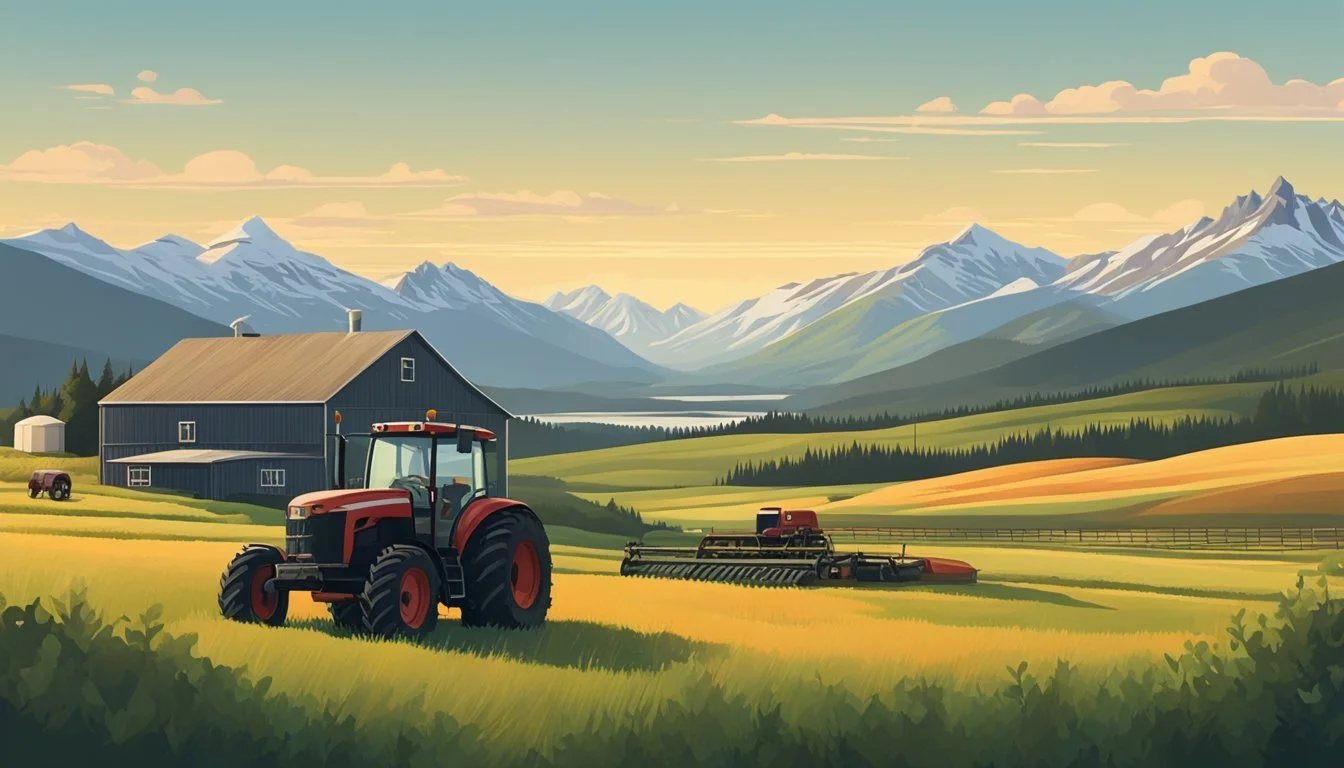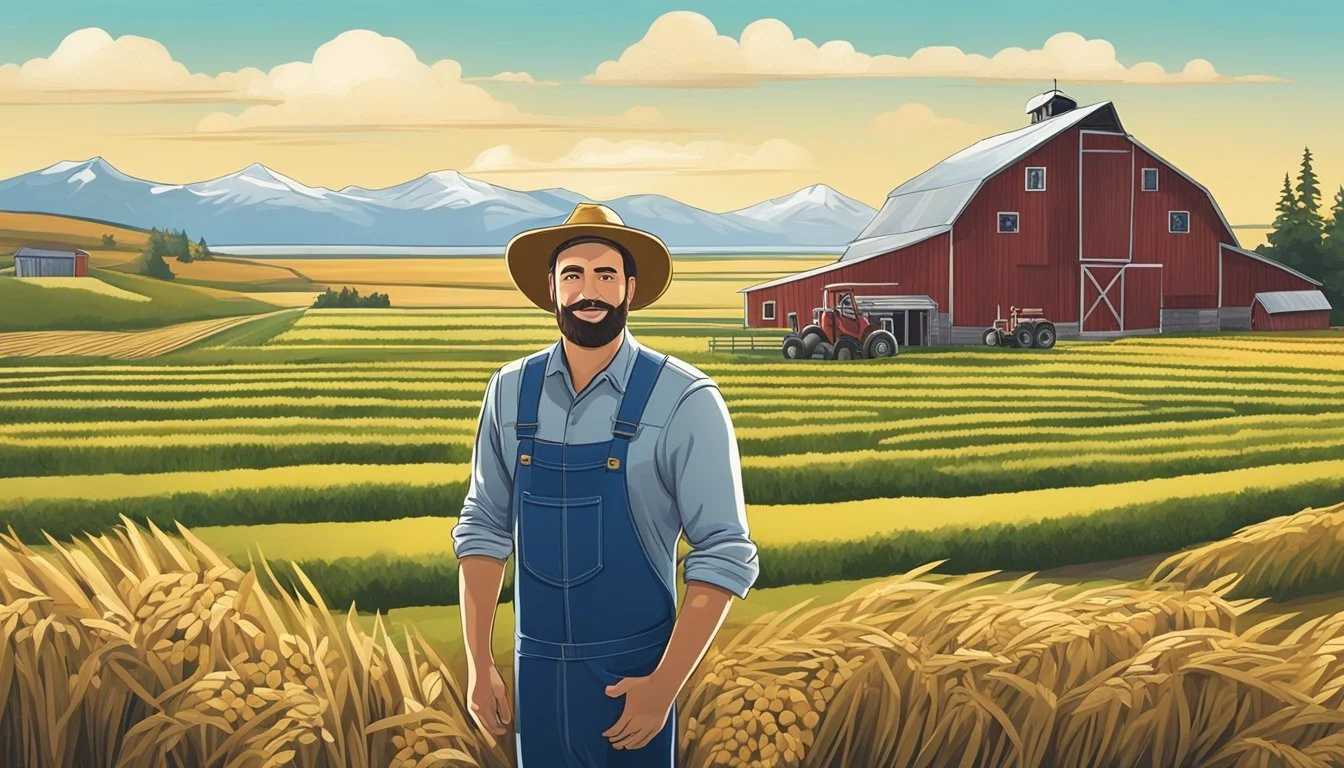Farm Loans in Alaska
Navigating Financing for Agriculture
This Article is Part of Our Guide on Farm Loans for All 50 U.S. States
Securing financing is a fundamental step for farmers in Alaska looking to establish, maintain, or expand their agricultural operations. Farm loans provide the necessary capital to acquire land, purchase equipment, and cover operating costs, which are essential for a healthy and sustainable agricultural business. In response to these needs, various programs by entities like the USDA Farm Service Agency offer financial products tailored to different scales and types of farming. These include loans aimed at everything from family-sized farms to larger operations, with provisions for youth, new, and experienced farmers.
In Alaska, farm loans are designed to accommodate the unique challenges posed by the state's climate and geographical features. The financial support extended through loans plays a vital role in ensuring that local agriculture thrives despite these challenges. It is not just federal programs that offer such financial solutions; state agencies and private financial institutions also provide specific loans and financial services suitable for farmers, ranchers, and associated rural businesses in the state.
Agricultural producers, in turn, have access to a variety of loans, including those used for building farm infrastructure or making improvements to existing operations. Borrowers can seek assistance from agencies and financial cooperatives within the region for expert credit counseling and to navigate the spectrum of available financial options. This ensures that Alaskan farmers receive support tailored to their individual needs, promoting the sustainability and growth of the state's agricultural sector.
Overview of Farm Loans
Farm loans in Alaska provide crucial financial support to family farmers and ranchers. These loans enable the development, building, and sustaining of family farms, which are central to a thriving agricultural economy in the state.
Understanding Farm Loans
Farm loans in Alaska are designed to cater to the financial needs of the state's agricultural sector. These are typically issued by the Farm Service Agency (FSA), which is a branch of the United States Department of Agriculture (USDA). Farm loans offered in Alaska include funding for purchasing land, buying equipment, and other operations critical to a farm's success. Prospective borrowers must meet the eligibility criteria set forth by the FSA, which often covers credit requirements and the operational scale of the farm.
Types of loans available through the USDA's Farm Service Agency include:
Operating Loans: For purchasing items like livestock, farm equipment, and operating costs.
Farm Ownership Loans: Aimed at helping farmers purchase or expand a farm.
Microloans: Designed for smaller needs, which may include start-up expenses.
Youth Loans: To support the entrepreneurial activities of young individuals in agriculture.
Farm Plus Financial is another resource offering commercial loans to Alaskan farmers, indicating a mix of federal and private financing options are available to borrowers.
Importance of Farm Loans in Alaska
Farm loans play a significant role in maintaining Alaska's agricultural productivity. Considering that Alaska's environment can be challenging with its diverse and often extreme climates, farmers may require more substantial initial support, from acquiring land to constructing facilities. Farm loans afford farmers the financial flexibility to invest in essential infrastructure, such as irrigation systems and non-residential buildings for processing agricultural products.
Loans aimed at development, such as those for land clearing and product processing, directly impact Alaska's economy by enabling the processing of local agricultural products. This is pivotal in reducing dependence on imported goods and reinforcing the local agricultural market. With appropriate financing, Alaskan farmers can overcome some of the geographic and climatic constraints, fostering an agricultural industry that is both competitive and sustainable.
Types of Farm Loans Available
Farm loans in Alaska provide critical support for the agricultural community by offering financial resources to cover various farm-related expenses. Farmers have access to tailored loan programs to satisfy their specific needs, whether for operational improvements, land acquisition, or emergency situations.
Operating Loans
Operating Loans are designed to assist farmers with daily business operational expenses. These can include purchasing livestock, seed, and equipment, and can also address the farm's operating costs as well as family living expenses during the startup phase.
Farm Ownership Loans
Farm Ownership Loans, on the other hand, aim to support farmers in acquiring land. These loans are useful for expanding an existing farm, making capital improvements, or paying closing costs. A pivotal step for farmers looking to acquire ownership and build their operations.
Youth Loans
Youth Loans cater to the younger demographic, specifically individuals below the age of 21 who are eager to engage in agricultural projects. These loans are often foundational for youth to establish projects that can be displayed at agricultural fairs or similar activities, thereby nurturing the next generation of farmers.
Emergency Loans
When natural disasters strike, Emergency Loans ensure that farmers have a means to recover. These loans can help in the restoration or replacement of essential property, cover production and living expenses, and restructure debts due to physical or production losses.
Direct and Guaranteed Loans
The USDA makes Direct Loans to farmers with the agency directly providing the farm financing, while Guaranteed Loans are made by lending institutions and backed by the USDA. Both play crucial roles in offering capital, with direct loans assisting those who may have trouble obtaining credit and guaranteed loans stimulating rural lending markets through risk mitigation.
Eligibility and Requirements
When seeking farm loans in Alaska, applicants must meet certain eligibility criteria, provide adequate collateral, and satisfy credit requirements. Understanding these stipulations is crucial to securing the necessary funding for agricultural endeavors.
General Eligibility Criteria for Alaska
To be eligible for a farm loan in Alaska, individuals or entities like partnerships, corporations, or joint ventures must demonstrate their capability to manage and operate a family-sized farm. An applicant should be a family farmer and not a large-scale operation. They are often required to also be a citizen, a permanent resident, or have legal status allowing them to operate a business in the United States. For specific programs, there are further nuances, such as loans for beginners or established farmers, and sometimes youth programs are available.
Citizenship: U.S. citizen, permanent resident, or legal status
Operation scale: Family-sized farm management and operation
Entity types: Individuals, partnerships, corporations, joint ventures
Residency: Must operate within Alaska
Collateral and Loan Securing
Farm loans require collateral to secure the loan. This collateral often includes the real property or assets being financed, like land or agricultural equipment. Lenders assess the value of the collateral to ensure it matches or exceeds the loan amount. The assessment establishes a margin of security protecting the lender's interests in case of borrower default. For certain loan types, other assets may be considered as collateral.
Collateral requirement: Adequate property or assets
Valuation: Sufficient to cover the loan amount
Margin of security: Protects lender in case of default
Understanding Credit Requirements
Credit requirements for farm loans involve a borrower's credit history and an evaluation of their ability to repay the loan. Lenders look for responsible repayment behaviors, reasonable debt-to-income ratios, and an assessment of the farm's financial viability. Potential borrowers should prepare a detailed loan application, demonstrating financial planning and projected capability to fulfill the loan's conditions.
Credit history: Proof of responsible repayment behavior
Debt-to-income ratio: Must reflect the ability to service the loan
Financial assessment: Includes viability of the farm business plan
The loan application process in Alaska evaluates a borrower's eligibility, the sufficiency of collateral, and the borrower's creditworthiness. These factors combined determine the feasibility of loan approval.
Loan Application Process
The loan application process for farmers in Alaska involves several crucial steps to ensure candidates are thoroughly prepared and evaluated for eligibility. Farmers need to compile the necessary documentation, undergo credit counseling, and be ready for ongoing supervision once they secure financing.
Preparing the Loan Application
When preparing their loan application, applicants must ensure all parts of the form are accurately completed. This includes specifying the type of loan required, whether it's for farm ownership or operating expenses, and the desired loan amount. A well-prepared application increases the chances of a smooth approval process.
Identify Loan Type: Specify whether it's a Farm Ownership or a Farm Operating Loan.
Loan Amount: Clearly state the desired amount, keeping in mind the maximum allowed for microloans is $50,000.
Documentation and Paperwork
The documentation stage requires precision and attention to detail. Loan applicants must submit various forms of paperwork, including financial statements, evidence of farming experience, a business plan, and proof of collateral.
Financial Statements: Balance sheets and cash flow projections.
Farming Experience: Documented evidence of sufficient farming experience or qualifications.
Business Plan: A detailed plan for the farm’s operations and financial projections.
Collateral: Proof of assets to secure the loan.
Credit Counseling and Supervision
Credit counseling is strongly recommended to help applicants understand the financial implications of taking out a loan and managing farm debt. For successful applicants, ongoing supervision by the loan agency ensures adherence to the loan conditions and provides assistance in financial management.
Credit Counseling: Guidance on managing loans, budgets, and debt.
Supervision: Regular check-ins by the loan agency to monitor the business’s financial health and mentorship for success.
Financial Terms and Conditions
In Alaska, farmers seeking loans must navigate various financial terms and conditions tied to rates, fees, and repayment structures. Understanding these conditions is essential for securing the right loan for their agricultural needs.
Rates and Fees
Alaskan farm loans typically come with moderate interest rates to promote agricultural development. However, fees may vary depending on the lender and loan type. For example, some institutions may charge application fees or origination fees.
Type Description Expected Range Interest Rate Moderate Rate for Ag Loans Varies by Lender Fees Application, Origination Based on Loan Product
Repayment Terms and Loan Amounts
Loan amounts can range significantly, from as low as $200,000 to as high as $50,000,000, catering to diverse agricultural scales. Repayment terms also vary, and the maximum term may be contingent upon the loan type. Farmers should expect to provide proof of repayment ability when applying.
Maximum Loan Amount: Usually up to $300,000 for direct loans
Repayment Terms: Structured based on the farmer's ability and loan type
Understanding Fixed and Variable Rates
Loans can have fixed or variable rates. A fixed rate remains unchanged over the loan term, providing predictability in budgeting. In contrast, variable rates can fluctuate over time based on market conditions, often being adjusted annually.
Fixed Rate: Unchanged throughout the term
Variable Rate: Can adjust, potentially annually
Borrowers must consider their financial stability and market predictions when choosing between fixed and variable rates to secure the most beneficial terms for their farming operations.
Specialized Loan Programs
In Alaska, farmers and ranchers have access to various specialized loan programs designed to meet their unique agricultural financing needs. These programs offer support ranging from the purchase of land to the provision of disaster relief, often tailored to the specific circumstances of agricultural businesses in the state.
Alaska's Agricultural Revolving Loan Fund (ARLF)
The Agricultural Revolving Loan Fund (ARLF) functions as a state-run program offering long-term financing solutions. It primarily benefits farmers seeking to purchase land, equipment, or livestock, and it can also be used for constructing or improving farm buildings. Interest rates for ARLF loans are competitive, creating an appealing option for local agribusinesses.
FSA Loan Types and Programs
The Farm Service Agency (FSA) within the USDA administers a variety of loan programs in Alaska:
Farm Ownership Loans: These loans assist farmers in buying or expanding a farm.
Operating Loans: For financing day-to-day operations or purchasing livestock, equipment, feed, seed, and more.
Disaster Assistance Programs: FSA offers loans for farmers affected by natural disasters with programs like the Emergency Conservation Program and the Noninsured Crop Disaster Program.
These FSA programs are crucial for supporting Alaska's farmers through different stages of their business ventures and during times of hardship.
Other Ag Financing Options
Apart from ARLF and FSA, other financing options are available:
Agribusiness Financing: Tailored for larger agribusiness operations, covering needs from production to processing.
Fisheries and Forest Products: Specialized loans for fishery and aquaculture operations, as well as customized solutions for forest product-related businesses.
Alaskan agricultural businesses can leverage these diverse financing programs to support and expand their operations, ensuring the state's agricultural sector thrives in various market conditions.
Loan Management and Success
Effective loan management is crucial for the success of farming operations in Alaska. It requires a close partnership with a loan officer, a careful balance between loan costs and farm operations, and strategic planning for loan repayment.
Loan Officer and Lender Relationship
The relationship between a farmer and their loan officer lays the groundwork for managing loans successfully. It is essential for borrowers to maintain transparent communication with their lender and be proactive in sharing their farming operations plans and any challenges they face. A strong partnership with the loan officer ensures that they have all the necessary information to help the farmer navigate any financial situations that may arise.
Balancing Loan Costs and Farm Operations
Farmers must achieve a delicate balance between their loan costs and the sustainability of their farm operations. They should create detailed budgets that reflect both the cost of the loan, including interest rates and any associated fees, and the operating costs of the farm. A well-managed budget helps in identifying areas for cost savings and ensures that farm operations generate enough income to cover outstanding balances.
Strategies for Loan Repayment
Implementing strategies for loan repayment is a critical component for achieving long-term financial stability in the agricultural sector. Farmers can work with their loan officers to develop a repayment schedule that aligns with the farm's cash flow patterns. They should also consider creating a contingency plan to cater for unexpected disruptions to their operations, which ensures continued success in repaying loans on time.
Additional Resources
Access to comprehensive resources is essential for Alaska's farmers and ranchers to thrive. From government-backed programs to community cooperatives, a plethora of educational and financial support mechanisms are in place.
Educational Materials and Workshops
Division of Agriculture provides a wealth of educational resources, including materials on best practices in agriculture and opportunities for workshops. These educational services are invaluable for both nascent and seasoned farmers seeking to enhance their knowledge and skills in agricultural production.
Government and Non-Profit Support
A variety of government and non-profit organizations offer support to Alaska's agricultural community. The USDA Farm Service Agency, for example, facilitates programs for disaster relief, farm loans, and commodity price support. Additionally, the Agricultural Revolving Loan Fund (ARLF) is designed to spur the development of agriculture throughout Alaska with moderate interest rate loans.
Networking in Alaska's Farming Community
Networking with fellow farmers is crucial for farmers residing in rural communities. Cooperation and shared knowledge among agriculturalists is fostered by various farm credit services and agricultural cooperatives, which can offer financial services and additional support to their members. By engaging with these networks, farmers can access new opportunities, share risk management strategies, and increase their market reach.
Conclusion
In Alaska, both private and federal entities recognize the vital role of agriculture and offer a range of loan programs to support it. The USDA's Farm Service Agency (FSA) is a key player, providing various loan options, such as Farm Ownership Loans, Farm Operating Loans, and emergency programs. They are also involved in conservation efforts through initiatives like the Conservation Reserve Program (CRP).
Entities like Farm Plus Financial cater to Alaskan farmers, offering loans between $200,000 and $50,000,000, ensuring that agricultural capital needs can be met for a range of operations. The presence of specialized programs reflects a commitment to tackling historical issues, with programs designed to address past discrimination in USDA lending.
Local efforts, as outlined by the Cooperative Extension Service, focus on specific developmental needs like property purchase, non-residential construction, and agricultural facility enhancements. Program availability seeks to underpin the sector's stability and growth.
Farmers in Alaska should carefully consider these programs and their eligibility requirements—each designed to fund, support, and enhance various aspects of the agricultural industry. These programs not only facilitate farm ownership and operation but also emphasize sustainable practices and remediation after emergencies. Acknowledging these options provides a foundational step towards a thriving and sustainable agricultural industry in Alaska.










